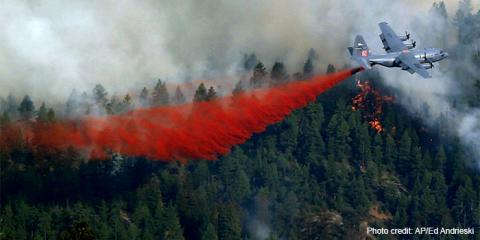Fires burn through remediation funds
September 30, 2013
By late August, the US Forest Service had exhausted its firefighting budget for the year. A billion dollars spent, and there were still about 50 large, uncontained fires burning nationwide.
So the Forest Service transferred $600 million from other purposes – such as recreation and timber management – to fund firefighting for the rest of the season. They didn’t have much choice, really; in many cases homes and communities were at stake.
But let’s remember a few things:
- This is the sixth time in the past 12 years this has happened.
- Fire risks in our national forests continue to escalate.
- Over the past few years there’s been a decrease in funding for thinning and fuel reduction projects – the very projects that would help prevent big, expensive fires in the first place.
Nationwide, the USFS did preventative work on 1.8 million acres in 2012. Less is happening this year. And next year’s budget provides funds for still fewer acres – down to 685,000 nationwide. In Oregon alone, there are millions of acres of national forest in need of restoration.
All this was reported in a recent Associated Press news story, and anyone who read it certainly must have had the same thought: What are we doing wrong?
Certainly, the Forest Service understands the irony. And so do many of our political leaders in Oregon.
Gov. John Kitzhaber, for instance, has compared this to problems in health care. He said it’s like not paying a relatively small amount to control someone’s high blood pressure, and then paying tens of thousands of dollars to treat that person in the hospital after he or she suffers a stroke.
In Oregon, we’ve had some success using collaborative groups to plan forest restoration projects that can help prevent expensive fires, with interests as diverse as environmentalists and mill owners working together. A Forest Service study released this year shows these projects do reduce costs.
Restoration of National Forest lands is something that can be resolved; not easily, however. The US Forest Service cannot do it alone, as has been demonstrated over the last two decades.
This is a problem of federal policy and federal funding. It’s going to play out in Washington, D.C. – in the Obama administration, in Congress and high up the food chain in the Agriculture Department.
OFRI’s 2012 Forest Report has as its No. 1 recommendation: “Reassess and reshape policies for Oregon’s federal forests.” It points out that “This is a tall order … not achieved with a single ‘summit’ or with a 90-day planning effort … A sustained bipartisan effort is needed.”
As our elected officials address forest policy, we need to focus on substance – avoiding the rhetorical and supporting sensible outcomes as our congressional delegation works through this conundrum.
Ray Jones
OFRI board member
Photo: A military C-130 drops a load of fire retardant on a wildfire near Pine, Colo., on Wednesday, June 19, 2013.
